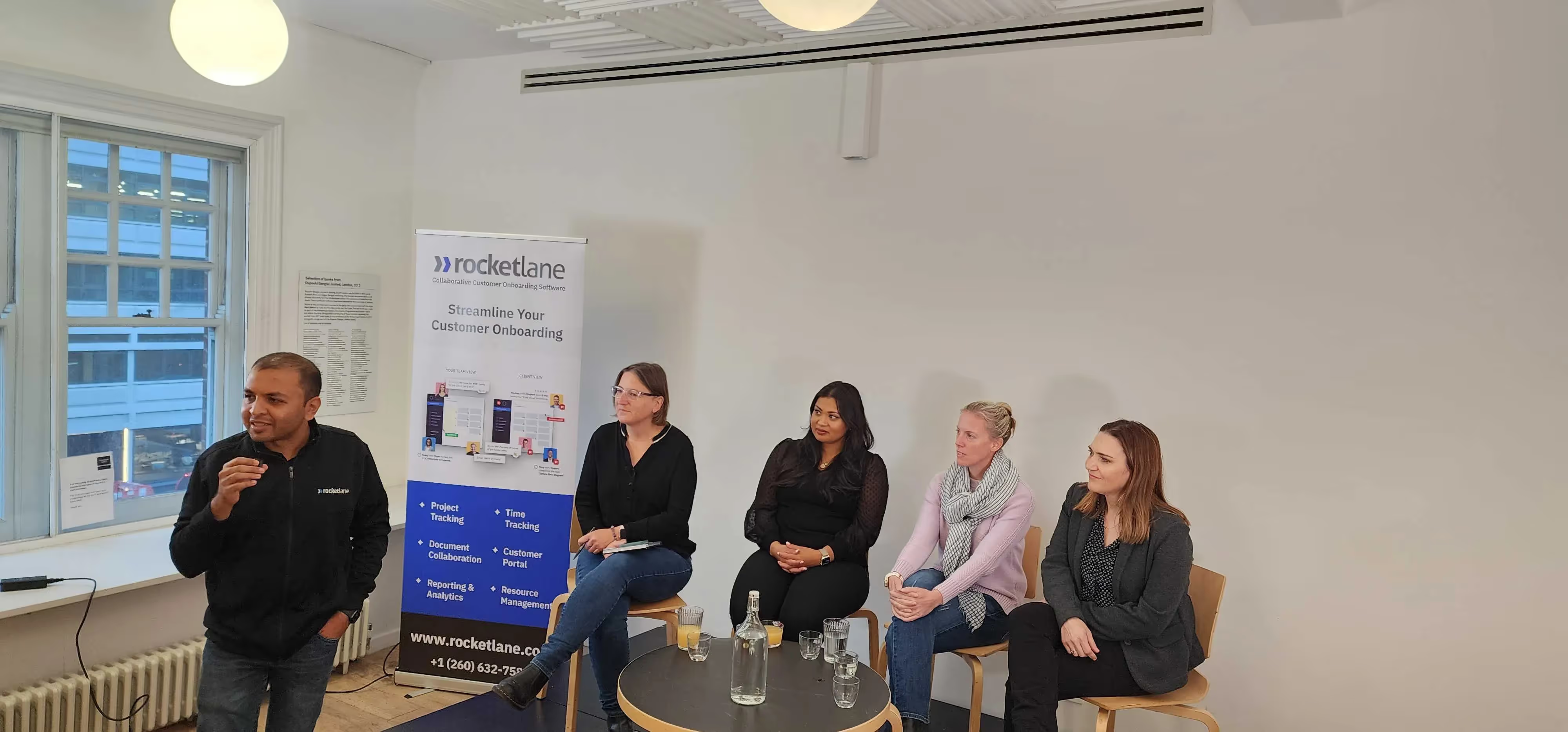The Preflight Community hosted a panel of leaders in the onboarding, implementation, customer success, and professional services domain on November 8 in London at our first-ever in-person Huddle in the EU and UK region.
The discussion was moderated by Celine Caux, Director of Professional Services at GoCardless. Our theme was the impact of budgeting in the post-sales org. 2022 has been challenging and full of lessons on how budgeting impacts IT spending and its consequences, including internal org restructuring. It’s the year that will allow us to brace for the impact 2023 will have on the economy.
Our panel of experts shared their experience of wading through uncertainty in the past two years, the change that the economic shifts have brought to SaaS, lessons they learned along the way, and how to make strategic decisions that positively impact your overall business goals.
Before we dive into takeaways from the session, here is a little about the panelists:
Céline Caux, Director of PS @ GoCardless
GoCardless is a payment solution with around 70,000 customers worldwide. We support our customers to make, receive, and process payments, one-off or recurring. We work with open credit and direct banking solutions. Budgeting is impacting our professional lives more than ever. We must talk about this in the larger community!
Anika Zubair, Co-founder of CSM LDN
Most recently, I served as VP of Customer Success at Karbon. We are a work management software solution for accountants. They’re highly aware of budgets. For the last decade, I have been working in Customer Success, primarily building out post-sales organizations. I focused on everything from implementation, support, customer success, and professional services, helping grow and scale to the 50 million revenue marker. Before this, I was at Insided, a community tool acquired by Gainsight.
Star Hofer, CCO @ PartnerStack
I have been in SaaS my entire career and only worked at startups. PartnerStack helps companies power their indirect software solutions. We’re trying to disrupt how a sales motion can scale in these indirect solution spaces. I love building! I have experience building various post-sales orgs, everything from customer onboarding, support, professional services, success management, Ops, and account management under the umbrella of CS. I’m exploring how these two can blend in!
Deborah Andrews, COO @ Unit4
I have got 15 years of experience, mainly around the Salesforce ecosystem. My experience at Gainsight helped me learn and grow as a leader. In the past, I have managed CS, Support, and Operations teams. I worked with ISBs of Salesforce and their clients, which led to the transition into CS. I specialize in CS Ops at Unit4. We have five products across nine verticals in five different regions. We acquire startups and work to ensure their continued success in product and service offerings. We make the process seamless for everyone by proactively solving the challenges of acquisitions.

Panelists (L to R): Céline Caux, Anika Zubair, Star Hofer, and Deborah Andrews
Now on to the top ten takeaways from the Preflight Huddle London.
1. Empathy is key during tough times
When IT spending has been reduced or scaled back as much as possible, the challenge has been how to digitize the success aspect, manage the resources we have in our teams, and how engineering can help with the digitization in the success org. A considerable risk we are all aware of during the budget cutbacks is that our customers are in the same boat as us. And during times like these, empathy is critical!
2. Challenge your Ideal Customer Profiles and address the challenges early
Startups invest heavily in headcount, but the metrics we are evaluated on have changed. Earlier, money was cheap. On the one side, startups could afford to throw people at the problem. However, that’s no longer the case. Investors are looking at efficiency metrics, unlike earlier when they were looking at growth metrics like net new booking, etc. As a result of this new math, we are forced to figure out how to do more with less. And technology is the best way to do that!
The challenge is also figuring out if you have the right ICP, but at a time when you’re not in a position to reject new business, you need to figure out answers to questions like:
- Why are they choosing you if they’re coming in organically?
- Do you want to create a new product offering?
- Are you tracking the right ICPs?
- Why go against the grain? Why can’t you go with a grey, instead of a black-and-white approach to ICP?
- What if you create a product offering for those who don’t fit into your current ICP?
3. Be more effective with your team and your time
The hiring freezes will carry forward to 2023, and we are all on the path to becoming more effective with our money. This calls for building super-efficient processes with existing resources. Customer onboarding, implementation, CS, and PS tools will become the savior in running a lean post-sales org while not limiting or restricting business.
Product-led and digital-led growth for a few customer segments will help you provide value and see your customer use your product without the heavy lifting that the post-sales org has to do.
Figure out what the customer needs, their barriers, and the gaps you need to fill in. Segmenting your customers will help you put them in broad buckets, divide your resources amongst each, and lean in on the bigger accounts that need more support. Experiment with those where your falls a side of the desk solution for them.
4. Translations are a challenge
You should bid goodbye to silos inside your orgs if you want to function and be successful together. SaaS offerings will have to cover more ground with existing resources. Digital and tech lead for the right segments will help you cover the ground.
The transition from wanting to give customers everything they need to a point where they value your time will come with a lot of iterations. Create functional roles as part of the digital team. Make these teams experts in each function, including customer onboarding and adoption, to drive and excel in what they do.
Additionally, monetize your CS! Create custom packages for your customers with information on success management, support, and service deliverables. Your customer will be ready to pay for your offerings if you assure them value and get to this value in a time frame that they cannot say no! Getting them to value faster will be a powerful lever in monetizing your customer success org. This type of paid motion will force them to be invested as you are in achieving success.
5. Assure your customers of your commitment
When your CS packages are paid for, it is vital to assure your customers and keep up with your assurances. When the only constant is that everything is changing very rapidly, it is a necessary practice to make sure that you show yourself as a trusted partner in the customers’ journey. Show them how their success with your offering is a metric you are tracking diligently.
6. Recommendations on driving tough procurement negotiations
Resiliency planning is the best place to start. Have a plan B, C, D, and even Z if you need to! This method works best for mid-market and enterprise, where it is a one-on-one conversation.
When you’re talking to SMB, and one-on-one conversations are impossible, the play has to be different. Look at everyone in a certain portfolio and try to negotiate in mass.
Take a look at your book of business. If you have a price increase that you automatically put on there, and you know very well that a particular cohort of SMBs operate in a specific price point and do not get a lot of pushback, go back to them and make the offer. It might be a down-sell for you, but the smartest thing to do is still retain their business and have the logo!
7. Pivots in how businesses justify value to their customers
The pivot has to be perspective. Revaluate how your org sees value; it could be a shift from looking at value in terms of the currency you report in and looking at a more qualitative metric like the relationship you build with your customer.
Gross and net revenue retention will always be north stars for a post-sales org. Choose a qualitative metric that will help you get there.
Indirect sales, upselling, and cross-selling need to be prioritized right now. In doing so, the post-sales org needs to be equipped with the proper training and tools to drive this priority.
8. The evolution of renewal conversations
Have the renewal conversation as early as possible, even as early as kickoff! Renewal conversations should be ongoing. Make a list of the things you can offer and how you have kept up your promises and fulfilled your deliverables.
With SMBs, however, the challenge could be that you’re figuring out the budget. In this context, renewals could be transnational. See if doing the expansions anytime during the life cycle would make more sense than driving expansion on a cyclic motion.
9. Durable growth for post-sales organizations
Fix the leaky pipes. The most important thing across the post-sales org is to figure out where your customers are churning—knowing this will help you dig into the why and when of the churn.
It is essential that pre- and post-sales organizations be aligned on the ICP. However, having customers that slip through the cracks is a familiar problem. Even more so if you’re selling to SMBs. During times like these, when you have to be very thoughtful about refusing new business, it’s important to know why they have bought your product. Are they desperate for revenue? Is it the messaging that sold them an idea you did not intend to sell? The more you know about the purchase decision, the better position you are in to decide what direction to take.
10. Lessons from 2022 for 2023 and what makes you future-proof
Double down on knowing what you do well. When crises arise, businesses try to scatter and run in all directions and expand into new verticals, but doubling down on what makes you stand out will help with stable growth.
Ask yourself what you’d do if you could go back and redo it. It’s an excellent way to evaluate your decisions and see what you’ve missed. Articulate what you’re trying to solve and whom you should hire.
This is the time for team enablement, creating experts, and developing expertise in industries or functional teams. Create playbooks of the processes that work and aim for a quality that makes it repeatable.
As leaders, it is your responsibility to ask hard questions. 2023 will also be when leaders in the space must tell their talented team members that it is time for them to move on. We owe it to our business and the team to make these tough decisions and do it the right way.
…
Being part of a strong and supportive community will help everyone feel less lonely during tough times. Help someone find the support they need along their journey.
At Preflight, we want to open doors for people to form lasting connections, create a safe space for conversations, and build thought leadership in the onboarding, implementation, CS, and PS spaces.

























.webp)